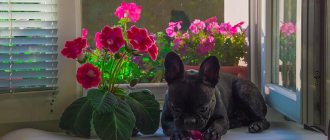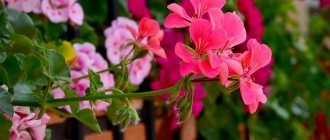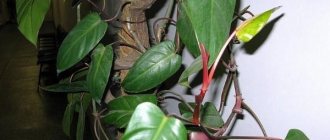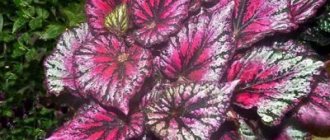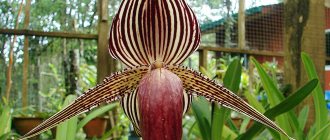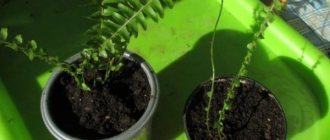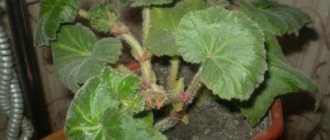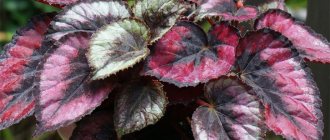The genus of begonias includes about 1000 species; it is the largest group of the Begoniaceae family. Among them there are annual and perennial herbs and shrubs. Ever-flowering begonia (lat. Begonia semperflorens) is an ornamental crop grown at home and in open ground. Its homeland is hot and humid South America. The houseplant is grown as a perennial; it has absorbed all the best qualities of the mother forms used for breeding. In the garden, begonia is used in all types of flower beds and is grown for one year.
Description
Semperflorence belongs to the Begoniaceae family . The natural habitat of the flower is Bolivia, Brazil and the northern regions of Argentina.
In begonia's usual habitat, the length of the shoots is usually in the range from 0.1 to 0.7 m; in culture it can reach a meter in length.
Interesting! The main selection is aimed at breeding low-growing varieties suitable for long-term indoor cultivation.
The begonia semperflorens bush is formed by a large number of shoots branching from the very base.
The shoots, like the leaf petioles and veins on the back of the leaf blades, have a distinct reddish tint. The leaf blades are fleshy, round, with a pronounced sharp tip and jagged edge.
Usually rich green, but hybrid varieties boast a wider palette :
- bronze shade;
- chocolate;
- with a burgundy tint;
- with shades of red.
Flowers (male and female) are collected in loose racemes. The color of the petals is very diverse - from white-pink to coral. Flower growers especially value terry begonia with bright red corollas .
Varieties of evergreen begonia
Semperflorence is divided into three groups according to the height of its shoots.
Tall
The height of such plants is about 0.4 m and above . Tall begonias are distinguished by large leaf blades and equally large flower cups (some fully opened buds can reach 60 mm in diameter).
Medium height
Medium-sized plants include bushes whose height does not exceed 0.3 m . The size of the leaf blades of such bushes is noticeably smaller than that of tall varieties, and the flowers are smaller.
Low-growing or dwarf varieties
The height of such bushes does not reach 0.2 m . The leaves and flowers are quite small, but such flowers have a higher adaptive capacity than their taller counterparts.
Dwarf begonias look great both in open ground and in flowerpots and pots.
Where does the begonia flower grow?
In the wild, begonia grows in tropical rainforests and high mountain regions. Most begonia species are found in Argentina and Brazil, Venezuela and Bolivia, Peru and Chile, India, Pakistan, the Malay Islands, Sri Lanka and the western part of the African continent.
Despite suitable climatic conditions, the begonia flower does not grow in the vast expanses of Australia and the islands of Polynesia. In indoor conditions, these flowers can grow all over the world, the main thing is to create the necessary microclimate for begonias.
Popular varieties with photos
Among the huge number of hybrid varieties, every gardener will be able to choose an interesting specimen for himself. The most popular are begonias.
Alba
This begonia can often be found in a flower bed. Its tall (up to 0.45 m) spreading bush looks good in ridges and flower beds.
Begonia is grown as an annual and is renewed annually, since the plant gives large (up to half a meter) annual growth.
It is distinguished by the rich dark green color of the leaves with a light waxy coating and large white flowers, collected in brushes of 14 pieces.
Albert Martin
Belongs to the dwarf varieties of ever-flowering begonia. It has small, dense green leaves with a pronounced reddish border along the edge and small flowers of a bright purple hue, collected in brushes of 9 pieces.
Ambassador F1
A medium-sized hybrid that unites a series with a noticeable red border along the edge of the petals. Easy to care for and resistant to adverse factors.
Bada boom F1
A medium-sized variety with a bush height of up to 0.25 m. The plant is noteworthy for its leaf blades with a pronounced bronze tint.
Bella
A low begonia with a shoot height of about 19 cm. This variety attracts the attention of flower growers with its lush flowering, because almost one and a half hundred flowers can bloom on a bush at the same time.
Bicola
A dwarf variety with very beautiful and vibrant flowering. The flower petals are painted in a light, almost perfect white tone with a red stripe along the edge.
Bowshin
The variety grows from 0.2 to 0.4 m in height. Attracts attention with the bright pink flowering of small corollas, with which the bush is densely strewn.
Havana scarlett
An attractive low-growing variety up to 0.2 m high with bronze foliage and red flower petals.
Galla lilu F1
The size of the hybrid is up to 0.2 m, but the bush attracts attention with light shading on the leaves and bright red-pink corollas.
Emperor red F1
The hybrid grows up to 30 cm. It has a large number of shoots with rather large single red flowers.
Begonia cocktail
It is distinguished by a pronounced bronze tint of the leaves, which creates a bright contrast with the light tone of the petals.
Carmen
Medium-sized variety with highly decorative dark brown leaf blades. The background of the leaves perfectly sets off the light color of the flower petals.
Kate Teicher
A tall variety with high decorative qualities. Its large, richly colored foliage and bright scarlet flowers also attract attention to the plant.
Queen F1
A low bush up to 0.2 m tall with rich green leaf blades differs from other ever-blooming begonias in its densely double flowers. The color of the petals can be:
- white;
- pink, both light pink and rich shade;
- red.
Begonia lotto
Belongs to medium-sized varieties. The color of the petals can be either white or deep red or pink.
Lucenets F1
A dwarf hybrid with a very interesting double color of petals. On a soft white background, a bright pink or crimson border is clearly visible.
Magma F1
A very attractive dwarf hybrid that requires virtually no care. It is distinguished by its rich chocolate color of leaves and bright red flower petals.
Olomouc F1
Dwarf hybrid, one of the most famous. It is distinguished by the milky white color of the petals and vigorous flowering.
Othello
The height of the bush rarely exceeds 0.2 m. The plant is notable for the fact that it easily forms into a ball, densely dotted with small scarlet flowers.
Begonia senator
It is considered one of the best hybrids with abundant branching, a large number of bronze leaves and an incredible number of small flowers collected in racemes.
Sprint plus F1
Hybrid series. Flower petals can be colored pink, red or white. The size of the plant is small, only up to 0.25 m.
Stara F1
A large variety whose height can reach up to half a meter. The leaf blades are a rich reddish-green hue, and the large beautiful flowers are white or pink.
Vision F1
A medium-sized hybrid with leaves of a rich dark green hue. Large flowers can be white, pink, red or coral.
Fiona F1
A low plant up to 0.2 m in height has strong, well-branched shoots, small leaf blades with a uniform green color and bright red-pink double and semi-double flower petals.
Fertilizer and feeding of begonias
To form flowers, the plant needs nutrition. At the moment of bud formation (and this happens throughout the growing season), mineral and organic nutritional compositions are added. Fertilize the plant every 2 weeks.
Rules for applying fertilizing:
- At optimal temperatures (18-22°), food is absorbed much better.
- Nutrient compositions are applied in the evening, after moistening the soil in the flowerbed.
- It is necessary to water at the root, but without the solution touching the plant.
Important! Despite the fact that ever-flowering begonia loves food, you should never overfeed it. Excess nutrition leads to the death of the tropical guest.
Special preparations are used to fertilize begonias:
- “Begonia” will help provide you with potassium and phosphorus, macroelements and microcomponents.
- “Bona Forte for begonias” will help the plant adapt to negative external environmental factors.
- “Good Power” will fill it with nitrogen, phosphorus and other useful components for abundant flowering.
Proper nutrition will help the plant gain strength and produce a large number of buds. With regular dosed fertilizer, flowering continues throughout the growing season.
Advice! Begonia responds gratefully to the addition of 2 g of boric acid and 1 g of manganese. The products are diluted in 10 liters of water and watered the flowerbed.
Planting in open ground
The exotic, whose homeland is equatorial countries, will not survive the harsh Russian winter. Therefore, the flowerbed will have to be updated every year . But what an opportunity to see a variety of varieties of evergreen begonia!
Deadlines
Already grown seedlings are planted in the ground . The optimal planting time will be mid-May, when the soil has already warmed up sufficiently and the threat of recurrent night frosts has completely passed.
Selecting a location
In order for semperflorence to bloom profusely and beautifully all summer, attracting attention, you need to choose the right place on the site .
Attention! Although the everblooming begonia is native to the warmer regions of America, direct sunlight falling on the flower all day can cause burns on the delicate leaves.
You should not plant seedlings in dense shade either: such conditions will cause the sprouts to stretch out, and the flowering will be faded and indistinct.
Give preference to areas where the bright sun will illuminate the plantings before noon and after five o'clock in the evening , and in the midday heat they will be shaded.
Soil preparation
Begonia prefers loose, nutritious soil . Before planting seedlings in the ground, it is important to disinfect the soil by spilling it with a solution of potassium permanganate.
Attention! Be sure to lay a drainage layer before planting flowers. Prolonged contact of roots with moisture will lead to plant rotting.
If the soil on the site is too heavy and lumpy, it should be loosened by adding peat and calcined river sand.
Landing
Thanks to the variety of colors and sizes of plants, gardeners create incredible compositions in flower beds of ever-flowering begonias.
Prepare holes for planting seedlings:
- Pebbles or crushed bricks are placed at the bottom of each to ensure good drainage.
- It is good to add a layer of rotted compost on top: this will provide the flowers with nutrients.
- The holes are dug at a distance of at least 10 cm from each other so as not to thicken the plantings.
- The sprouts should fit freely in the hole so that the roots can be easily straightened.
- There is no need to deepen the plant too much; the root collar should be above the surface of the ground.
Dormancy and flowering period
Usually, indoor plants go into a dormant phase after a period of active flowering, but evergreen begonia, living up to its name, can actually bloom almost continuously. The only exceptions to this rule are those plant varieties that have a tuberous root system. By mid-autumn, watering such begonias should be gradually reduced; if the flowerpot was on an open veranda, bring it indoors and then, after about two weeks, stop watering the ground completely.
Usually by this moment the flower dries out and sheds all the green part, but if this does not happen, armed with a sharp knife, you should cut it off at the root. Now the flowerpot needs to be wrapped in several layers of newspaper, placed in a dark place (it’s good if it is cool enough, with a temperature of no more than 10–15 ° C), not watered or fed, thus left in a state of complete dormancy until the end of winter.
An alternative wintering option is to remove the tuber from the pot and store it in peat and even in the vegetable section of the refrigerator, but this method is more often used when growing ever-flowering begonias in open ground.
Important! Young tuberous begonias (less than one year old) do not need wintering. Their growth is still too active, it does not stop with the onset of cold weather, so if such a plant is cut off and stopped watering, it will most likely die. In winter, it is better to simply move such flowers to a cooler, but sufficiently lit place and slightly limit their watering.
For begonia varieties that have a fibrous root system, limiting watering and fertilizing in winter is carried out only if the temperature and lighting in the room where the flower stands are very different from summer conditions. However, since apartments and private houses are equally warm in winter and summer, such flowers can do without a resting phase.
Outdoor care
Caring for semperflorence in a flower bed is not difficult, but you should still follow the basic recommendations in order to admire the abundant flowering.
Watering
The soil around the bushes should always be slightly damp.
Important! Do not allow the soil to dry out: this will lead to the death of the flowers.
When watering, try not to let water get on the leaf blades . Often such an oversight leads to rotting of the leaves.
Water the ever-flowering begonia with settled warm water early in the morning or after sunset.
Feeding
To maintain flowering, for flowering plants are regularly applied along with watering The frequency of fertilizing should not exceed 1 time in 14 days.
Wintering
To preserve the plant, with the onset of autumn, the bush is dug out of the flowerbed and transplanted into a pot . Such a plant can be kept in the house during the winter and then planted again in the flowerbed in the spring.
If it is not possible to keep the plant in an apartment, then the pot with begonia can be stored in a room with an air temperature of at least 10 ° C.
New shoots when stored in this way need to be regularly pinched until the onset of spring.
Possible problems
If you care for indoor begonia evergreens incorrectly, the following problems may arise with it:
- Flying leaves . The room is too cold.
- Wilting of leaf blades . The plant feels an acute lack of moisture. The watering regime needs adjustment.
- The bush blooms sparingly . Lack of nutrients or excessively poor lighting.
- The foliage fades and dries up . The room is too hot and dry. Place the bush on a tray with moistened expanded clay and moisten the air around it with a spray bottle.
- The foliage turns yellow . The room is cool + high humidity. It is recommended to replant the bush and move it to a more suitable location.
- Small white spots appear on the foliage . The bush is sick with powdery mildew. Treatment with a fungicidal preparation is required.
- Brown and black spots are visible on the leaf blades . The flower is affected by a fungal disease - botrytis. To combat it, a fungicide is used.
- The foliage has rotted . The leaves were moistened with a sprayer. If the damage is not severe, then all diseased leaves should be cut out. If the damage is severe, then the flower cannot be saved. Healthy cuttings are cut and rooted.
- Pests . Scale insects, thrips and whiteflies may settle in. They are destroyed with insecticidal agents.
Planting and care at home
to grow ever-flowering begonia at home from seeds . To do this, prepare low (up to 150 mm) wide containers, fill the bottom with a drainage layer and select a loose, slightly acidic substrate.
You can use ready-made soil intended for begonias. The seeds are distributed over the surface, moistened and placed in containers with crops in a warm, well-lit place.
Lighting and temperature
For the full development of home semperflorens, you will need a lot of bright, but diffused light .
It is optimal to place a pot of ever-flowering begonia on an east or west window. If the flower is on the south window, then it must be shaded at midday.
Begonia is tolerant of high temperatures and easily tolerates even extreme heat , of course, provided that the soil is properly moistened.
But low temperatures combined with drafts can destroy a flower in a very short time.
Watering and air humidity
The optimal air humidity for keeping semperflorence is 50% .
Important! Ever-blooming begonia does not tolerate spraying. Water that gets on the leaves can cause unsightly spots and rot.
It is optimal to use water trays or automatic humidifiers for humidification.
You need to water the flower often, in small portions; the ground should always be slightly damp . But under no circumstances should you allow moisture to stagnate in the pot.
Feeding
The flower needs active feeding during the period of spring growth of green mass and in summer. At this time, fertilizing is applied along with watering once every two weeks. In autumn, the frequency of fertilizing is reduced to 1 time per month; In winter they can be canceled altogether.
To maintain the strength of semperflorence, ready-made mineral complexes are used.
Trimming
Most ever-flowering begonias do not require pruning or bush formation . It is enough just to pinch off excessively elongated shoots and from time to time remove undiscarded wilted buds.
Interesting! Semperflorence has the ability to self-clean, so it is necessary to forcibly remove wilted buds only in rare cases.
Transplants
Only young plants need regular replanting . Adult bushes undergo only partial soil renewal.
Wintering on the windowsill
Semperflorence can overwinter in two ways:
- Cut off the entire above-ground part and place the pot in a cool, dark place until spring.
- Leave the flower in the same condition as it grew over the summer. By the time winter sets in, the temperature in the room is reduced to 15 °C, the amount of watering is reduced, and fertilizing is completely canceled until spring.
Reproduction
Growing begonia from seeds
Everyone would like to have as many different types and varieties of flowers as possible on their plot or in their home. Some people prefer only a few species; it is these that flower growers actively cultivate and propagate, planting their favorites in all suitable places.
Begonia evergreen, like other plants of this type, can be propagated in two ways:
1 Seed is used quite rarely; it is usually used by breeders to create new hybrids with different basic characteristics. Purchased seeds usually correspond to the variety and type stated on the package, but if you decide to collect the grains yourself, there will be no guarantee that the characteristics of the standard will be preserved. The seed method involves sowing pre-prepared seeds into the ground for seedlings; after sowing, the container is covered with film or glass, creating a greenhouse effect.
Within two weeks, shoots should appear; after the appearance of the second pair of true leaves, young begonias are transplanted into individual containers and grown for another 2-3 weeks. After the threat of frost has passed, the plants are planted in open ground and watered twice a day for the first week. Gradually, watering is reduced; subcortex is not added during this period; a small amount of it is added to the soil in which it is planned to plant the grown seedlings. After about a month, you can try to slightly fertilize the soil around the young trunks.
Begonia cuttings
2 By cuttings you can achieve better results; all the original characteristics of the mother plant are fully preserved. To do this, at the end of summer, after flowering has ended, young shoots up to 10 cm long are cut from the trunks you like. It is important to ensure that the branch has several pairs of leaves and living buds. It is advisable to dry the sections, but they can be rooted using several methods.
The simplest and fastest is rooting in water; for this, the prepared cuttings are lubricated with a root growth stimulator and placed in a container with water. After 7-10 days, the first roots will appear, after which the young plants can be planted in prepared soil and grown indoors until spring. The second method will have to be tricky; the cuttings are dried at the cut, treated with ash and planted in wet sand.
The container is covered with film, regularly watered and ventilated. If the procedure is carried out correctly, after two weeks the cuttings will take root and begin to develop. It is during this period that it is important to remove the film and place the container on the windowsill. There is no need to apply fertilizing and fertilizers in the first 4-6 weeks; the substances can have an aggressive effect on the weak root system. After the specified period, you can slightly stimulate the development of leaves and faster strengthening of the rhizome in the soil at its permanent place of “residence”.
It is not worth dividing the bush, nothing good will come of it, none of the separated parts will be able to grow normally. If, by a lucky chance, part of the divided bush is accepted, the threat increases that the trunk will often get sick, it can be attacked by various diseases and pests, which over time will cause its death.
Priming
Begonia is not picky about soil; it will grow and develop well on almost any soil, the main thing is that it is slightly acidic and loose. The knocked down soil will not allow the trunk to easily develop roots, through which the entire plant receives nutrition. Gradually, the begonia in such a place will gradually wither, its development will lag significantly, and foliage and buds may be shed.
Variety Semperflorence
To avoid this outcome, dense soils must be loosened regularly or the correct soil mixture must first be prepared, which will not require such careful attention.
Particular attention should be paid to drainage; the plant will not tolerate stagnation of water both in the pot and in the flowerbed for long
The consequence will be a variety of putrefactive diseases of the stems and leaves of the trunk, which will eventually lead to the death of the entire plant.
To sow seeds and plant cuttings, prepare a special soil mixture yourself, for this you take:
- two parts of humus
- two parts of leaf soil
- one part sand
The ingredients are mixed well and left for a day in the room to warm up. Only after this can you sow seeds or plant cuttings with a root system. First water the prepared soil well and slightly dry it, this will allow the seedlings to grow and develop better. No fertilizing is applied during this period; the seeds and seedlings will receive proper nutrition from humus.
Feeding and watering
Growing in a flower bed requires periodic watering of the trunks, no more than once every three days in hot weather. It is worth thinking about drainage for begonias in advance; this will help keep the trunks in perfect condition for a long time and save the grower from problems with diseases and pests that are attracted by high humidity around the begonia trunk.
Plant in open ground
Watering is carried out only during dry summers, if it rains extremely rarely and the air is very dry. To increase humidity, you can spray the space near the plants.
Begonia will need fertilizing within a month after planting in open ground, if a homemade soil mixture was used before planting. It reacts best to minerals; it is advisable to add organic matter in the spring when preparing a bed for a flower bed. In the summer, nutrients are added along with water, they are dissolved in previously prepared and heated water, and then carefully applied under each bush.
You can make it simpler, take a more concentrated solution, dilute it in water for irrigation and bring it directly from a watering can to the plants, but if nutrients get on the leaves under the influence of the sun, burns will occur, which can cause the death of an adult healthy trunk. So don’t be lazy, in order to have a beautiful, lush flower bed, apply fertilizing strictly for each seedling of plants used in the garden.
Care errors
Flower growers often encounter problems caused by mistakes in caring for ever-flowering begonias.
Frequency problems:
- Dry leaves . The reason is too dry air or insufficient watering.
- The appearance of rot on a bush can be caused by low temperatures combined with excessive moisture.
- The leaves turned yellow and began to fly off . The reason is too low temperature and high humidity.
- The leaves have lost their color intensity - the flower does not have enough sunlight.
- Lack of flowering can be caused by low temperature, drafts, or excessive amounts of fertilizer. A pot that is too large or unsuitable soil can also cause harm.
Read about other annuals:
Petunia Gioconda multiflorum: flower carpet
Brachycoma – 11 varieties bloom all summer
Diseases and pests
Plant leaf disease
Begonia, like all garden plants, is periodically attacked by various diseases and pests. Most of them are attracted by improper care of the trunks; single mistakes cannot provoke the development of parasites and destroy the plant.
Powdery mildew can periodically affect begonia, this happens due to stagnation of water or its lack in the soil. Only fungicides can help; there is no other way out.
Root and leaf rot affect trunks during sudden changes in temperature and high humidity. At the beginning of the process, it is worth removing the affected areas and treating the cuts with ash, but if most of the plant is affected, then it is better to get rid of it completely.
Whitefly, thrips, and scale insects will not allow evergreen begonias to grow and bloom normally. This scourge can only be combated with the help of chemicals.
Begonias are often used in group plantings in flower beds of various styles of landscape design. They are not picky, easy to care for, look great and delight the eye with their appearance for a long time.
Combination with other plants
When kept indoors, evergreen begonia is tolerant of other indoor plants.
In a flowerbed, the flower goes well with ground cover plants . Semperflorence looks good next to alyssum, verbena, and cineraria.
Growing everblooming begonia is easier than it seems. Even a novice gardener can do this plant.
The use of begonia in landscape design
Designers use garden begonia when arranging alpine slides and decorating summer cottages. Plants are planted on ridges.
Important! Potted everblooming begonias add color to a green lawn.
Hanging varieties are suitable for decorating gazebos and gazebos. Landscape architects decorate park flower beds and rocky hills with begonias. Entrance areas are decorated with plants in flowerpots.
Ever-blooming begonias can be grown outdoors, providing proper care and protection from pests. These perennial plants have many subspecies - about 16 hundred varieties. Begonias develop in the form of vines, shrubs and subshrubs.
